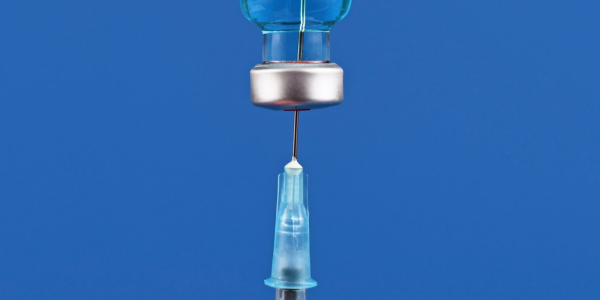
Oxytocin: The Hormone of Love

Oxytocin is a neurohormone with many functions.
It’s responsible for initiating childbirth, and research has shown that Oxytocin plays a key role in maternal behavior and bonding between mother and child in non-human mammals.
Oxytocin is called “the Hormone of Love” because it’s also released during sex in humans. It’s theorized that oxytocin may help us form social bonds, and it may also make social interactions more rewarding and enjoyable.
Studies show that people who maintained Oxytocin levels during negative emotions were less likely to report interpersonal problems.
Through these results, it can be theorized that Oxytocin can help improve sex, sociability, and mood.
Common Uses for Oxytocin
- Mood (depression and anxiety)
- Addiction/recovery (alcohol and opioids)
- Female Sexual Dysfunction or FSD (intimacy, arousal, orgasm)
- Men who have issues with intimacy
- General sexual dysfunction (men/women)
Note: The FDA has not yet approved oxytocin for treating these disorders.
Oxytocin for hypoactive sexual desire disorder (HSDD)
Oxytocin has traditionally been used to facilitate child labor, prevent post-delivery hemorrhaging, and help initiate or increase lactation.
However, there’s a growing interest in using Oxytocin for Hypoactive Sexual Desire Disorder (HSDD) and Female Sexual Dysfunction (FSD). Learn more about FSD and HSDD.
Oxytocin is naturally released from the brain in men and women to help regulate anxiety, stress-coping, and various social behaviors. As a result, Oxytocin has been used off-label to treat anxiety, depression, drug addiction, pain, and autism. Oxytocin can also be prescribed off-label to increase sociability, maternal behavior, and to increase sexual drive and function.
Oxytocin for hypoactive sexual desire disorder treatments usually involve a sublingual medication placed under the tongue, or an intranasal spray.
Oxytocin and Addiction
Neuropeptides like Oxytocin affect the central nervous system (CNS), and can affect processes related to opiate, ethanol, and cocaine addiction.
Oxytocin is created in the brain and released in both the posterior pituitary and the CNS. Oxytocin within the CNS has been shown to prevent the development of morphine and ethanol tolerance. In a study on mice, it was also shown to reduce the symptoms of morphine withdrawal.
When it comes to Oxytocin and addiction, oxytocin shows promise as a treatment but is not currently approved for use in this way.
Oxytocin Research and Evidence
A search of both PubMed and Cochrane Review databases was performed to identify available literature resources.
Oxytocin Summary of Evidence
Estimates for the incidence of HSDD, a subset of FSD, vary from one in 102 to one in 103 women. One of the agents being evaluated as a potential therapy is oxytocin.
Oxytocin is a small peptide (~1007 Da) which is mostly produced by the oxytocinergic neurons of the periventricular nucleus of the hypothalamus. A portion of these neurons extend into the posterior pituitary where oxytocin is stored until released peripherally into the bloodstream as a hormone.
Other oxytocinergic neurons extend to the amygdala, nucleus accumbens, hypothalamus, and hippocampus4,5 where the release of oxytocin acts centrally as a neurotransmitter. The central effects include increased trust and social interactions and reduced anxiety while having a low adverse events profile.4,6
In a study of couples, pulses of oxytocin were released when remembering instances of “love.”5 In animal studies, centrally administered oxytocin has been shown to initiate proreceptive behavior.4
In addition to the traditional uses of oxytocin, peripheral oxytocin is thought to cause increased intensity of orgasm in male and female patients via increased smooth muscle contractions as evidenced by a positive correlation between increased blood plasma levels and intensity of orgasm.5,7
However, there is some disagreement whether these increased levels are the cause of or the result of orgasm.8 Desire is a function of both emotional and neurological inputs and is considered the first phase in the sexual response cycle.3
According to the dual control model, neurological control is accomplished through a balance between inhibitory and excitatory neurological processes4, and too much inhibition or inadequate excitation can result in a state of hypoactive desire. When released centrally, Oxytocin is an excitatory neuropeptide.4
Central acting agents are needed because some sexual disorders are psychogenic in origin and are not a result of a diminished ability to achieve or maintain physical sexual arousal. The concept of using centrally acting agents for the treatment of low sexual desire has been proven by the action of bremelanotide; however, adverse events prevented this agent from becoming commercially available.4
The idea of sexual desire begins in the mind with the excitement/arousal phase.2 Surveys have identified several factors important to women such as good mental health, good well-being, and positive relational feelings and expectations.2 In an analysis of women with sexual dysfunction, 64% experienced difficulties with desire, 31% with arousal, and 35% with orgasm.9
Although there are no human trials directly evaluating the use of oxytocin for treatment of HSDD, there are studies that indicate oxytocin strengthens characteristics such as pair bonding and perception of trustworthiness and attractiveness and therefore prosocial and affiliate behaviors.10,11,12
Safety
In a summary of human studies, the daily administration of 40 IU oxytocin intranasal have resulted in few adverse effects.10 In one study including three females, 160 and 320 IU daily (given in divided doses) were administered for a period of 7 days. The study reported “minimal” side effects at this dosing regimen.13 A limitation of the studies are that all used a small study population.
Innovation Compounding Dosing Recommendations
Common uses for oxytocin include treatment of FSD and lack of desire. The use of 25-50 IU oxytocin troches once daily is suggested to increase desire. Also, an additional 25 IUs assisting with arousal 20-30 minutes prior to coitus is recommended.
The use of oxytocin nasal spray 100 IU/mL is also recommended. Directions are one spray into each nostril once or twice daily as directed by physician.
Counseling Points
The oral disintegrating tablet (ODT) should be dissolved in the buccal cavity (cheek area, in the pouch between the inside cheek and gum). The ODT should not be chewed or swallowed. The nasal spray should be instilled into one nostril and held in the nostril passages by pinching the nostrils together. Patient can tilt head back to keep liquid in the nasal passages for at least 5-10 seconds.
These products should not be used by women currently receiving therapy for lactation, during pregnancy, and those taking oral contraceptives. Dosing is recommended at bedtime due to the potential for orthostatic hypotension. Side effects may include lightheadedness, vertigo, drowsiness, dry throat/mouth, abdominal pain, anxiousness, euphoria, calmness, and headache.6 No adverse events were reported in the short-term use of up to 40 IU.6
Some studies suggest (although weak), that using a low dose estrogen may potentiate the effects of oxytocin by increasing affinity to receptors. However, women who currently have adequate estrogen production or are currently taking hormone replacement therapy will not need additional estrogen therapy. There is no information regarding light sensitivity.
Oxytocin troches and nasal sprays should be kept refrigerated.
References
- Yanovski JA. Chapter 86. Pituitary Gland Disorders. In: Talbert RL, DiPiro JT, Matzke GR, Posey LM, Wells BG, Yee GC, eds. Pharmacotherapy: A Pathophysiologic Approach. 8th ed. New York: McGraw-Hill; 2011 http://www.accesspharmacy.com/content.aspx?aID=7992629. Accessed June 20, 2012.
- Clayton AH. The pathophysiology of hypoactive sexual desire disorder in women. International Journal of Gynecology and Obstetrics. 2010 Jul; 110(1):7-11
- Warnock J. Female hypoactive sexual desire disorder: epidemiology, diagnosis and treatment. CNS Drugs. 2002;16(11):745-53
- Pfaus J. Pathways of sexual desire. Journal of Sexual Medicine 2009;6:1506-1533
- Ishak WW, Kahloon M, Fakhry H. Oxytocin role in enhancing well-being: a literature review. Journal of Affective Disorders. 2011 Apr;130(1-2):1-9. Epub 2010 Jul 2
- Macdonald E, et al. A review of safety, side effects and subjective reactions to intranasal Oxytocin in human research. Psychoneuroendocrinology 2011 Sep:36(8):1114-26
- Meston C and Frohlich P. The neurobiology of sexual function. Archives of General Psychiatry. 2000:57;1012-1030
- Bancroft J. The endocrinology of sexual arousal. Journal of Endocrinology. 2005 Sep;186(3):411-27
- Clayton A. Epidemiology and Neurobiology of Female Sexual Dysfunction. Journal of Sexual Medicine. 2007;4(supplement 4):260-268


